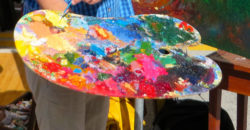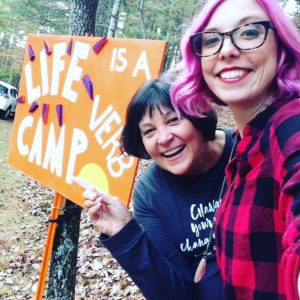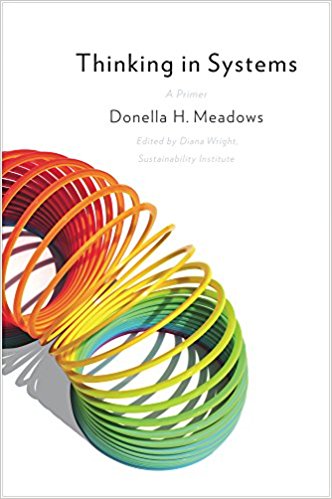Don’t look at the postcard
“Comparisons are odorous.” – William Shakespeare, Much Ado About Nothing, Act III, Scene V
 Let me just suggest something to you. There are very few things that I know for sure in life, but this is one of them: When a recipe states at the top of the instructions that it “depends on skill level,” it might be time to walk away.
Let me just suggest something to you. There are very few things that I know for sure in life, but this is one of them: When a recipe states at the top of the instructions that it “depends on skill level,” it might be time to walk away.
 Oh, if my 3-year-old only liked rectangles or squares, or even circles, I would be so happy. Note to self: introduce her to the happy solid-colored art of Alexander Calder or, better yet, Kasimir Malevich (see illustration). I could probably do a respectable Jackson Pollock cake, too. (And if you go to that Jackson Pollock link and put your cursor on the screen, you can create your own Jackson Pollock! Left click on your mouse and each time you do, you’ll get another color…)
Oh, if my 3-year-old only liked rectangles or squares, or even circles, I would be so happy. Note to self: introduce her to the happy solid-colored art of Alexander Calder or, better yet, Kasimir Malevich (see illustration). I could probably do a respectable Jackson Pollock cake, too. (And if you go to that Jackson Pollock link and put your cursor on the screen, you can create your own Jackson Pollock! Left click on your mouse and each time you do, you’ll get another color…)
I pushed past panic to the questioning stage: “What on earth was I thinking?” There were no answers, so I pushed on to the denial stage: “I think it looks good.” After denial came blaming: “If you had printed the picture bigger, I could tell how to lash this pretzel ladder on and attach the melting Fruit Chew ladder.” Blaming was followed closely by hysteria: “WHAT ARE YOU WAITING FOR? GET TO INGLE’S IMMEDIATELY FOR SOME CUPCAKES SO THESE POOR CHILDREN WILL HAVE SOME SUGAR TO CONSUME AT THE PARTY!” Shame came next: “I cannot possibly take this monstrosity out in public.” Then resignation and acceptance: “Tess is three. Her friends are three. What do they care?”
It was an exhausting day in my apron. Tess napped as I completed the decorating, twirling the green Fruit Chew hose into its resting place atop the truck, placing the licorice running board, icing the windows white. When she woke up, she ran into the kitchen. “WOW!” She loved it! And she got on her little ladder to see it close up; I was nervous—would she touch it and ruin it? She picked up a yellow M&M (not in my color scheme) and, as if in slow motion, her hand moved toward the cake. I stifled a “NO!” as she pushed it into the side of the cake. “LOOK! A BUTTON!” She spent the next 10 minutes decorating to her own satisfaction. I bit my Martha Stewart tongue.
 Twenty-four hours and some dozen failed pretzel ladders later, the big moment arrived. Tess and a few of her tiny friends joined the very fabulous members of Engine Company Number 1 for a special tour of the firehouse, sitting in the fire trucks, watching Tess’ big sister Emma try on fire fighter gear, and getting firefighter badges. Then we walked to a nearby children’s museum for play and sugar.
Twenty-four hours and some dozen failed pretzel ladders later, the big moment arrived. Tess and a few of her tiny friends joined the very fabulous members of Engine Company Number 1 for a special tour of the firehouse, sitting in the fire trucks, watching Tess’ big sister Emma try on fire fighter gear, and getting firefighter badges. Then we walked to a nearby children’s museum for play and sugar.
 nted to her M&M decorations, she pranced and danced and twirled, exclaiming her part in the cake to all her 38-inch-tall friends. Once they figured out that the dirt was made from Oreos, it was all over. The fire truck was demolished and eaten in 8 minutes flat, leaving only Fruit Chew hub cabs and a Dalmatian doggie candle on the tray.
nted to her M&M decorations, she pranced and danced and twirled, exclaiming her part in the cake to all her 38-inch-tall friends. Once they figured out that the dirt was made from Oreos, it was all over. The fire truck was demolished and eaten in 8 minutes flat, leaving only Fruit Chew hub cabs and a Dalmatian doggie candle on the tray.
Walk away. Run.
 I burned up the motor in my mixer on the first batch, requiring me to run to Best Buy and pick up that nice Kitchen Aid mixer I had always wanted. I figure the gingerbread project, once I added in all the equipment, the mixer, and supplies, was a good down payment on a new car. We found a pattern, requiring us to cut gingerbread dough into 1,218 pieces of intricate wall sections, bake them, and magically piece them together. After baking, we had no idea how to glue the pieces together. (By the way, gingerbread doesn’t remain perfectly flat while baking, in case you were wondering).
I burned up the motor in my mixer on the first batch, requiring me to run to Best Buy and pick up that nice Kitchen Aid mixer I had always wanted. I figure the gingerbread project, once I added in all the equipment, the mixer, and supplies, was a good down payment on a new car. We found a pattern, requiring us to cut gingerbread dough into 1,218 pieces of intricate wall sections, bake them, and magically piece them together. After baking, we had no idea how to glue the pieces together. (By the way, gingerbread doesn’t remain perfectly flat while baking, in case you were wondering).
 At around 3 a.m., we decided that it would be a project about castle ruins. This decision was further underscored when in a split second, our dog Blue ate the northwest corner of the structure. After watching these proceedings for about 20 hours, Blue performed like an NFL linebacker, studying the field until the opening appeared, lunging for the hole in our defenses.
At around 3 a.m., we decided that it would be a project about castle ruins. This decision was further underscored when in a split second, our dog Blue ate the northwest corner of the structure. After watching these proceedings for about 20 hours, Blue performed like an NFL linebacker, studying the field until the opening appeared, lunging for the hole in our defenses.
 “It is almost impossible (to see) because the Grand Canyon, the thing as it is, has been appropriated by the symbolic complex which has already been formed in the sightseer’s mind. Seeing the canyon under approved circumstances is seeing the symbolic complex head on. The thing is no longer as it confronted the Spaniard; it is rather that which has already been formulated–by picture postcard, geography book, tourist folder, and the words Grand Canyon. As a result of this preformulation, the source of the sightseer’s pleasure undergoes a shift. Where the wonder and delight of the Spaniard arose from his penetration of the thing itself, from the progressive discovery of depths, patterns, colors, shadows, etc., now the sightseer measures his satisfaction by the degree to which the canyon conforms to the preformed complex. If it does so, if it looks just like the postcard, he is pleased; he might even say, ‘Why it is every bit as beautiful as a picture postcard!’ He feels he has not been cheated. But if it does not conform, if the colors are somber, he will not be able to see it directly; he will only be conscious of the disparity between what it is and what it is supposed to be. He will say later that he was unlucky in not being there at the right time. The highest point, the term of the sightseer’s satisfaction, is not the sovereign discovery of the thing before him; it is rather the measuring up of the thing to the criterion of the preformed symbolic complex….”
“It is almost impossible (to see) because the Grand Canyon, the thing as it is, has been appropriated by the symbolic complex which has already been formed in the sightseer’s mind. Seeing the canyon under approved circumstances is seeing the symbolic complex head on. The thing is no longer as it confronted the Spaniard; it is rather that which has already been formulated–by picture postcard, geography book, tourist folder, and the words Grand Canyon. As a result of this preformulation, the source of the sightseer’s pleasure undergoes a shift. Where the wonder and delight of the Spaniard arose from his penetration of the thing itself, from the progressive discovery of depths, patterns, colors, shadows, etc., now the sightseer measures his satisfaction by the degree to which the canyon conforms to the preformed complex. If it does so, if it looks just like the postcard, he is pleased; he might even say, ‘Why it is every bit as beautiful as a picture postcard!’ He feels he has not been cheated. But if it does not conform, if the colors are somber, he will not be able to see it directly; he will only be conscious of the disparity between what it is and what it is supposed to be. He will say later that he was unlucky in not being there at the right time. The highest point, the term of the sightseer’s satisfaction, is not the sovereign discovery of the thing before him; it is rather the measuring up of the thing to the criterion of the preformed symbolic complex….”
 Go ahead, make the fire truck cake. Don’t settle for what’s easy—go for the Eiffel Tower sculpted from marshmallows, the class project made completely from gingerbread cut and baked into intricate, crenulated towers, the science project created entirely of licorice and white chocolate shavings. Why settle for easy?
Go ahead, make the fire truck cake. Don’t settle for what’s easy—go for the Eiffel Tower sculpted from marshmallows, the class project made completely from gingerbread cut and baked into intricate, crenulated towers, the science project created entirely of licorice and white chocolate shavings. Why settle for easy?







